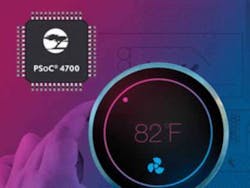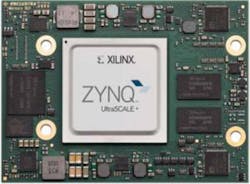Product Focus: Data converters—analog goes to the other side
Data converters are in the catbird’s seat during the migration to digitalization in the test and measurement world, as they are at the heart of many products. Beyond custom data converters built into an end product, you have many data-conversion options to choose from, including monolithic data converters, microcontrollers or SoCs with built-in data converters, and modules and boards with data-conversion functions.
Highlighted below are some specific options available.
General-purpose digitizers add more speed
This vendor has added five new models to its general-purpose M2p.59xx Series PCIe 16-bit digitizer cards. The new versions extend the performance range by increasing the maximum sampling rate from 80 MS/s up to 125 MS/s. The increased sampling rate, together with higher overall bandwidth, enables the new cards to capture a wider range of electronic signals. It makes them suitable for use in applications where signals in the DC to 50-MHz frequency range need to be acquired and analyzed with speed and accuracy. Based on 16-bit ADC technology, the new M2p-596x Series includes models that provide 1, 2, 4, or 8 input channels. Multichannel models each have their own ADC and signal-conditioning circuitry to allow fully synchronous acquisitions on all the inputs. Importantly, the high-resolution 16-bit ADCs deliver 16 times more resolution than digitizers using older 12-bit technology and 256 times more resolution than what is available from digital scopes that commonly use 8-bit ADCs. The extra resolution translates directly into improved measurement capabilities and superior dynamic performance. The complete product has been packed into a half-length PCIe card, yet it still offers a full set of digitizer features. Each channel has its own programmable input amplifier with ranges between ±200 mV and ±10 V, programmable input offset for unipolar measurements, programmable input termination of 50 Ωand 1 MΩ and an integrated calibration circuit. Models are available with up to eight single-ended and up to four differential channels. Spectrum
Precision, fixed-gain fully differential amplifiers
Touch-input microcontrollers
The PSoC 4700S Series microcontrollers (MCUs) use inductive sensing to detect touch inputs for products using metal surfaces, enabling reliable and waterproof human-machine interfaces. PSoC 4700S features include a 32-bit MCU subsystem, 48-MHz Arm Cortex-M0+ CPU, up to 32 kB flash and 4 kB SRAM, programmable analog blocks, one 10-bit, 46.8-kS/s single-slope ADC, two low-power comparators (CMP), two 7-bit IDACs configurable as a single 8-bit IDAC, one inductive sensing block that enables sensing of metal objects, one of the vendor’s CapSense blocks that supports low-power operation with self- and mutual-capacitance sensing, programmable digital blocks, five configurable 16-bit timer/counter blocks, PWM (TCPWM) blocks, and two serial communication blocks (SCBs) that are configurable as I2C, SPI, or UART. The PSoC 4700 Series is sampling now to lead customers with production expected in the third quarter of 2018. Cypress Semiconductor Corp.
Battery monitor with SAR ADC
The MAX17843 programmable, high-voltage, 12-channel battery-monitoring smart data-acquisition interface is optimized for batteries used in automotive systems, hybrid electric battery packs, electric cars, and any system that stacks long series strings of secondary metal batteries. This highly integrated battery sensor incorporates a high-speed differential UART bus for robust daisy-chained serial communication.
The analog front-end combines a 12-channel voltage-measurement data-acquisition system with a high-voltage switch-bank input. All measurements are done differentially across each cell. The full-scale measurement range is from 0 to 5.0 V with a usable range of 0.2 V to 4.8 V. A high-speed successive approximation (SAR) A/D converter digitizes cell voltages at 14-bit resolution with oversampling. All 12 cells can be measured in less than 142 µs. The MAX17843 uses a 2-scan approach for collecting cell measurements and correcting them for errors. This 2-phase approach optimizes accuracy over temperature and in the face of extreme noise in the system.
Two auxiliary analog inputs can measure external thermistor components. A negative temperature coefficient (NTC) thermistor can be configured with the AUXIN analog inputs to accurately monitor module or battery-cell temperature. A thermal-overload detector disables the MAX17843’s linear regulator to protect the IC, and a die-temperature measurement is also available. Maxim Integrated
MCU with 3-channel 10-bit ADC
The 8-bit STM8S001 microcontroller (MCU) comes in an SO-8 package and features I2C, UART, and SPI interfaces. With 8-kB flash memory, 1-kB RAM, 128-byte EEPROM, and 3-channel 10-bit ADC also on-chip, it delivers key features of the vendor’s STM8S003 MCU in a space-saving, low-pin-count device. Additional features include five GPIOs, one 8-bit and two 16-bit timers, and an internal RC oscillator that allows flexible clock control from 128 kHz to 16 MHz. A Single-Wire Interface Module (SWIM) supports programming and debugging. Fully specified from -40°C to 125°C and featuring the efficient STM8 core operating at 16 MHz, the STM8S001 is suitable for industrial devices like smart sensors and lighting controls as well as consumer products such as toys, small appliances, personal electronics, PC peripherals, and battery chargers. STMicroelectronics
MCU with 16-bit SAR ADC
To meet growing connectivity needs for buildings, factories, and the grid, the vendor’s newest SimpleLink wireless and wired microcontrollers (MCUs) offer low power consumption and concurrent multistandard and multiband connectivity for Thread, Zigbee, and Bluetooth 5 as well as sub-1 GHz communications interfaces. The expanded SimpleLink MCU platform offers designers 100% code reuse across the vendor’s Arm Cortex-M4-based MCUs.
The device’s 2 MB of flash memory and an integrated 16-bit SAR precision ADC give developers eight times more code space and the ability to host multiple wireless connectivity stacks and a 320-segment LCD with extended temperature range for industrial applications. The vendor says the precision ADC offers the highest effective number of bits (ENOB) of any integrated ADC, boasting 13.2 ENOB at 1 MS/s and up to 16 ENOB with software oversampling. The combination of 16-bit precision, ultralow sampling current, and integrated 8-channel DMA makes the MSP432P4 suitable for both high-performance and low-power applications. The module supports differential and single-ended inputs, and direct data transfer using DMA.
Texas Instruments
SoC module
The Mercury+ XU1 SoC module, based on the Xilinx Zynq UltraScale+ MPSoC, accommodates six ARM cores, a Mali 400MP2 GPU, up to 4 GB of fast DDR4 ECC SDRAM, numerous standard interfaces, 294 user I/Os, and up to 747,000 LUT4 equivalents—all on an area smaller than a credit card. Supported interfaces include Gigabit Ethernet, USB 3.0, USB 2.0, and PCIe Gen2 x4. Mercury+ XU1 offers up to 4 GB of DDR4 SDRAM with bandwidths of 19.2 GB/s and ECC as well as 16 GB of eMMC flash memory.
With the Mercury+ PE1-300 or Mercury+ PE1-400 baseboards, the Mercury+ XU1 can serve as a development and prototyping platform. Further expansion options are provided by the LPC/HPC FMC connectors on the PE1 base board, compatible with a range of plug-in options from various manufacturers, including ADCs, DACs, motor-control cards, and RF links. Enclustra
NFC smart-sensor IC
The AS39513 can be integrated into smart labels to enable efficient and accurate monitoring of the condition of assets such as food, pharmaceuticals, and healthcare products in storage and in transit. It includes an NFC front end, a temperature sensor, and an analog interface to an external sensor. Other functions integrated in the IC are a real-time clock, a 10-bit ADC, a configurable data-logging engine, a 9-kb password-protected EEPROM, and a serial peripheral interface (SPI) to connect to an external microcontroller. The AS39513 is available as a bumped die or in a chipscale package that is 0.3 mm high.
Powered by a single-cell or dual-cell battery, the AS39513 can store up to 1,020 time-stamped sensor measurements. Fully compliant with ISO15693 and NFC-V (T5T) standards, it can be read over a range of a few centimeters with an NFC mobile phone. An extended read range of 1 to 2 m can be achieved when using dedicated ISO15693 readers, offering the ability to read multiple AS39513 tags simultaneously in cabinets or refrigerators. ams
ADC and DAC board
The eight D/A converters accept baseband real or complex data streams from the FPGA’s programmable logic. Each 6.4-GS/s 14-bit DAC includes a digital upconverter with independent tuning and interpolations of 1x, 2x, 4x, and 8x. Each D/A output is transformer-coupled to a front-panel MMCX connector. Pentek Inc.






